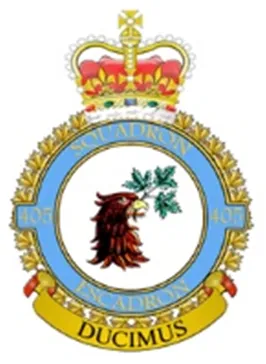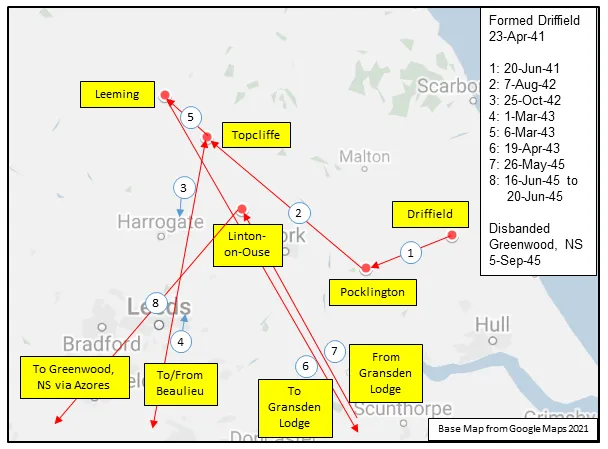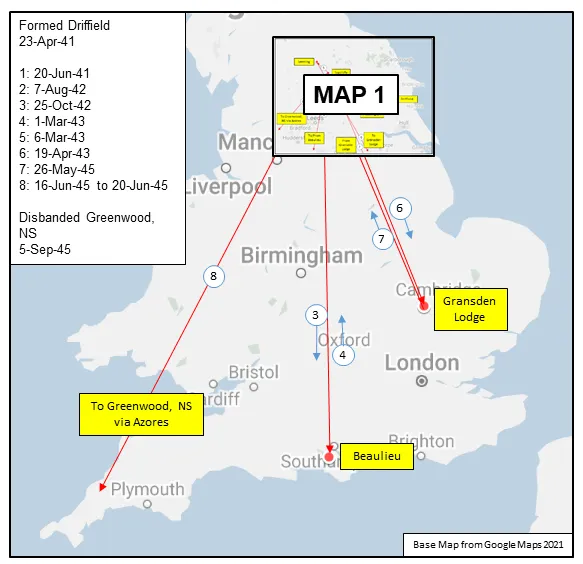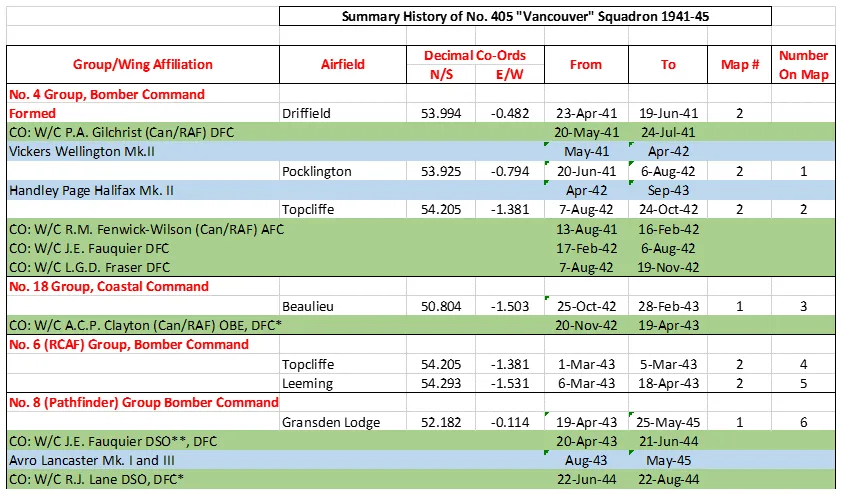Marcou, Howard Fortesque
Prisoner of War 1945-02-21
Service
RCAF
Unit
405 (PFF) Sqn- Squadron
Ducimus We Lead
Base
Gransden Lodge
Rank
Wing Commander
Position
Squadron Leader
Service Numbers
41350
PoW: None
Home
 Westmount, Quebec
Westmount, Quebec
Target
 Dortmund Germany
Dortmund Germany
Marcou, Squadron Leader Howard Fortescue, AFC C795 405 Squadron DFC awarded 20 February 1945 [correct] as per London Gazette of 1 March 1946 and AFRO 418/46 dated 18 April 1946. Born in Westmount (Montreal), 21 February 1917; home there; secured junior matriculation at McGill College. RCAF Provisional Pilot Officer, 3 January 1938; trained at Trenton; wings on 18 October 1938 under a short-lived pre-war scheme to provide pilots to the RAF
.Transferred to RAF, 5 November 1938; At RAF Station Uxbridge, 6-23 November 1938; at No.6 SFTS, Rissington, 24 November to 15 April 1939 (detached to Warmwell Practice Camp, 11 March to 6 April 1939); with No.52 (Bomber) Squadron, Upwood, 15 April to 27 July 1939; with Central Flying School, Upavon, 24 July to 12 September 1939; instructing with No.5 SFTS, Sealand, 13 September 1939 to 21 April 1941 (on detachment to Ternhill, 2 November 1940 to 21 April 1941); with Central Flying School, Upavon, 22 April 1941 to 1 January 1942; with No.2 Flying Instructor School, Montrose, 3 January 1942 to 26 April 1943 (Deputy Chief Flying Instructor); with Empire Central Flying School, Hullavington, 27 February to 26 May 1943; to No.2 FIS, Montrose, 27 May 1943 to 17 August 1944.
During this time he transferred to RCAF, 7 November 1943 (C795). Had been awarded AFC as a member of the RAF. To Pathfinder Night Training Unit, Warboys, 18 August to 3 September 1944; with No.405 Squadron, 4 September 1944 to 20 February 1945. He flew 31 trips (141 hours 50 minutes). Adventures with that unit including having his aircraft, Lancaster PB516, being struck by incendiaries from another aircraft. On the night of 20/21 February 1945 he went missing on operations (Lancaster PB530 \"W\"); reported safe in Britain, 24 April 1945.
In the postwar RCAF he reverted to Squadron Leader (1 October 1946), being promoted to Wing Commander, 1 September 1951. His major postings included Experimental and Proving Establishment, Rockcliffe, 21 September 1947 to 31 October 1949; Air Defence Group (later renamed Air Defence Command), 1 November 1949 to 3 April 1952; Canadian Joint Staff, London, 4 April to 9 September 1952; Air Defence Command, 10 September to 7 October 1952; Station St.Denis, 8-19 October 1952; Commanding Officer of No.12 Aircraft Control and Warning Squadron. Mont Apica (radar base), 17 August 1953 to 25 January 1956 (awarded Queen\'s Coronation Medal, 23 October 1953); Air Force Headquarters, 26 January 1956 to 3 January 1960; Northern NORAD Region Headquarters, North Bay, 2 August 1963 to 20 January 1964. He retired from the RCAF on 21 February 1966 and died in Drummond Township, Nepean, Ontario on 5 January 1999. This officer has completed, as pilot, numerous operations against the enemy, in the course of which he has invariably displayed the utmost fortitude, courage and devotion to duty.
NOTE: The types of aircraft he flew were sufficiently varied as to bear remark. Two forms, one filled in March 1948 and the other in June 1951, track his flying career. The numbers are not consistent from one date to the next, but the range of machines flown remains interesting: March 1948 June 1951 Single Engine Hart 85.55 64.55 Audax 60.40 48.20 Battle 51.20 44.35 Tutor 63.25 159.20 Harvard 11.10 47.50 Fury 8.05 1.45 Master 979.00 1,155.30 Hind - .20 Spitfire 2.40 5.00 Miles M.18 1.00 .30 Magister 62.20 70.05 Mustang 1.15 .45 Bermuda 1.40 .45 Bonanza - .30 Norseman - 4.00 Hotspur - .20 Finch - 65.00 Tiger Moth - 68.15 Twin-Engine Anson 82.35 153.00 Oxford 420.25 485.00 Dominie 12.15 5.20 Blenheim 10.15 8.55 Hudson 1.00 1.10 Whitley 1.00 1.00 Wellington 9.15 7.55 Expeditor 85.45 214.55 Dakota 10.20 57.25 Beaufighter - .45 Fairchild 71 3.05 - Canso 3.00 9.20 Ventura - 1.05 Multi-Engine Halifax 5.00 5.20 Lancaster 210.10 226.45 North Star - 17.25 Helicopters - 2.00
Directorate of History and Heritage file 181.001 D.24 has his ?Loss of Bomber Aircraft? questionnaire with his account of being shot down in Lancaster W/405, 20/21 February 1945, target Dortmund. He stated he had flown 30 sorties including this one. Narrative as follows: Aircraft W, Lancaster, took off from Gransden Lodge approximately 2200 hours. Set course, target Dortmund. Due on target at H plus 2 (approximately, i.e. about 0030 hours), 21 February 1945 as visual centrer (P.F.F.). Ran up on target through slight barrage flak. Dropped about one minute late (i.e. H plus 3) and waited for picture. Camera was turning over when hit by flak in port outer and No.2 starboard tank - both on fire. Ordered crew prepare bale out. About one minute later ordered crew bale out, having feathered and put out fire in port outer but tank fire was spreading rapidly. Saw all crew except Mid Upper Gunner and Rear Gunner bale out. Baled out myself. Landed in tree, gave self up to farmer as wounded in left knee and hand, making escape impossible. Wounds were received at same time as aircraft was hit. The website ?Lost Bombers? provides the following on his being shot down. Lancaster PB530, No.405 Squadron (LQ-W), target Dortmund, 20/21 February 1945. This aircraft was a Mk.III and was delivered to No.582 Squadron from No.32 Maintenance Unit in September 1944, joining No.405 Squadron on 12 October 1944. PB530 took part in the following operations: none with No.582 Squadron. With No.405 Squadron, Stuttgart, 19/20 October 1944; Essen, 23/24 October 1944; Dortmund, 20/21 February 1945 when lost. No accounting for the period 24 October 1944 - 20 February 1945. Airborne at 2220 hours, 20 February 1945 from Gransden Lodge. Cause of loss and crash-site not established by webmaster. Crew consisted of Flight Sergeant G.E. Bolland (killed, DFM gazetted 1 March 1946; left the aircraft by parachute but did not survive the descent); Squadron Leader H.F.Marcou, DFC, AFC, RCAF (injured); Flying Officer T.W.Downey (injured); Flying Officer R.O.Norse, RNZAF (injured); Flying Officer B.G.Smoker (injured); Flying Officer J.A. Lewis (injured); Flying Officer J.T.Ross. RCAF (POW); Technical Sergeant J.W.Verner, USAAF (injured). Survivors were confined in hospital due to injuries until liberation. No POW numbers. These details from Bomber Crew Forum
Lancaster Mk.I/III PB530
Bombing Dortmund Germany 1945-February-21 to 1945-February-21
405 (PFF) Sqn (RCAF) Gransden Lodge
Lancaster, took off from Gransden Lodge approximately 2200 hours. Set course, target Dortmund. Due on target at H plus 2 (approximately, i.e. about 0030 hours), 21 February 1945 as visual centrer (P.F.F.). Ran up on target through slight barrage flak. Dropped about one minute late (i.e. H plus 3) and waited for picture. Camera was turning over when hit by flak in port outer and No.2 starboard tank - both on fire. Ordered crew prepare bale out. About one minute later ordered crew bale out, having feathered and put out fire in port outer but tank fire was spreading rapidly. .All crew except Mid Upper Gunner and Rear Gunner baled out..
G.E. Bolland (killed, DFM gazetted 1 March 1946; left the aircraft by parachute but did not survive the descent); Squadron Leader H.F.Marcou, DFC, AFC, RCAF (injured); Flying Officer T.W.Downey (injured); Flying Officer R.O.Norse, RNZAF (injured); Flying Officer B.G.Smoker (injured); Flying Officer J.A. Lewis (injured); Flying Officer J.T.Ross. RCAF (POW); Technical Sergeant J.W.Verner, USAAF (injured). Survivors were confined in hospital due to injuries until liberation. No POW numbers.
Lancaster PB530
Avro Lancaster

Canadian Warplane Heritage Museum
The Avro Lancaster is a British Second World War heavy bomber. It was designed and manufactured by Avro as a contemporary of the Handley Page Halifax, both bombers having been developed to the same specification, as well as the Short Stirling, all three aircraft being four-engined heavy bombers adopted by the Royal Air Force (RAF) during the same wartime era.
The Lancaster has its origins in the twin-engine Avro Manchester which had been developed during the late 1930s in response to the Air Ministry Specification P.13/36 for a capable medium bomber for "world-wide use". Originally developed as an evolution of the Manchester (which had proved troublesome in service and was retired in 1942), the Lancaster was designed by Roy Chadwick and powered by four Rolls-Royce Merlins and in one version, Bristol Hercules engines. It first saw service with RAF Bomber Command in 1942 and as the strategic bombing offensive over Europe gathered momentum, it was the main aircraft for the night-time bombing campaigns that followed. As increasing numbers of the type were produced, it became the principal heavy bomber used by the RAF, the Royal Canadian Air Force (RCAF) and squadrons from other Commonwealth and European countries serving within the RAF, overshadowing the Halifax and Stirling. Wikipedia
405 (PFF) Sqn Ducimus ("Vancouver")
History of the Squadron during World War II (Aircraft: Wellington II, Halifax II, Lancaster I, III & X)

This was the first RCAF bomber squadron to be activated at Driffield, Yorkshire, England and flew its first mission on 12/13 June 1941. At that time it was a member of 4 Group of Bomber Command, and flew successively from Driffield, Pocklington and Topcliffe, Yorkshire, England. With Code Letters LQ It flew Wellington Mk II aircraft until converting to Halifax II in April 1942, in time for the first 1000-bomber raid on Cologne. In October 1942 it was transferred to Coastal Command No 18 Group, flying over the Bay of Biscay from Beaulieu, Hampshire. Returning to Bomber Command, the squadron joined No 6 (RCAF) Group and flew from Topcliffe and Leeming, Yorkshire in March and April 1943. It was then seconded to No. 8 (Pathfinder) Group and for the rest of the war flew from Grandsen Lodge, Bedfordshire, UK . Its first Pathfinder mission was on 26th April 1943, and its last on 25th April 1945. It was slated to become part of the "Tiger Force" to attack Japan, but the surrender of Japan precluded that, and the Squadron was disbanded at Greenwood, Nova Scotia on September 5th, 1945. One of the aircraft that flew briefly with the squadron was the first Canadian-built Lancaster Mk. X, KB700, christened the "Ruhr Express", which was subsequently transferred to 419 Sqn RCAF in December 1943.Overall, the squadron flew 4427 sorties, of which 349 were with Coastal Command and 41 were in Operation Exodus, the repatriation of POWs. Nearly 25000 operational hours were logged together with 12,000 non-operational, and 12,856 tons of bombs were dropped. In the course of operations, 167 aircraft were lost with 937 aircrew. In the course of its history, squadron members were awarded 9 DSO's, 161 DFC's and 24 Bars to DFC's, 38 DFM's, 2 CGM's 2 BEM's and 11 MiD's. Battle Honours were: Fortress Europe 1941-44, France and Germany 1944-45, Biscay Ports 1941-45, Ruhr 1941-45, Berlin 1941; 1943-44, German Ports 1941-45, Normandy 1944, Walcheren, Rhine; Biscay 1942-43.Moyes, Kostenuk and Griffin
Squadron History (Bomber Command Museum PDF)
Maps for Movements of 405 Squadron 1941-45
 MAP 1: 405 Squadron Movements in Yorkshire 1941-45 (right-click on image to display enlarged in new tab) |  MAP 2: 405 Squadron Movements in England 1941-45 |
405 Sqn History Summary 1941-45

405 Sqn History Summary 1941-45 Page 2

History of the Squadron Post-WWII (Aircraft: Lancaster X, Neptune, Argus I & II, Aurora)
The squadron was re-formed as No 405 (Maritime Reconnaissance) Squadron at Greenwood, Nova Scotia on 31 March 1950, and redesignated No 405 (Maritime Patrol) Sqn on 17 July 1956. The squadron was the first of four formed in Maritime Air Command. It flew modified Lancaster Mk. X aircraft until mid-1955, when they were replaced by P2V7 Lockheed Neptunes, which gave an enhanced anti-submarine capability. and the first to fly Lancaster, Neptune and Argus aircraft on East Coast maritime duty. In April 1958 the squadron was given the distinction of being the first to fly the Canadian-built CP-107 Argus. The squadron made its last flight in the Argus on 10 November 1980 before introducing the CP-140 Aurora. On 1 February 1968 the squadron was integrated into the Canadian Armed Forces. It is now designated No 405 Long Range Patrol Squadron, flying from Greenwood, NS.
The squadron’s primary combat functions are Anti-Submarine Warfare (ASW) and Anti-Surface (ASUW). The Squadron regularly trains for its roles by participating in a number of naval exercises at home and abroad. However, most of its time is taken up in a number of non-combat roles, including search and rescue and support to other government departments, including counter-drug operations with the Royal Canadian Mounted Police (RCMP) and fisheries patrols with the Department of Fisheries and Oceans. Year-round, the Squadron carries out sovereignty patrols covering the Canadian Arctic Archipelago and maritime areas of interest . During these patrols, 405 LRPS crews maintain a constant vigil for ships that discharge pollutants illegal at sea. Similarly, its crews verify that foreign and Canadian fishing vessels abide by their Canadian licensing agreements and report suspected violators to DFO patrol boats.
405 LRPS regularly deploys to a number of allied bases for an assortment of exercises and missions. Among its international training sites are US NAS Keflavik (Iceland), US NAS Sigonella (Sicily, Italy), US NAS Oceana (Virginia, USA), US NAS Jacksonville (Florida, USA), US NAS Roosevelt Roads (Puerto Rico), UK RAF Kinloss (Moray, Scotland),UK RAF Station St. Mawgan (Cornwall, England) and NL NAS Valkenburg (Netherlands).



 Library and Archives Canada Service Files (may not exist)
Library and Archives Canada Service Files (may not exist) Lancaster Bomber
Lancaster Bomber Wikipedia
Wikipedia Harold A Skaarup Web Page
Harold A Skaarup Web Page